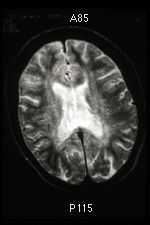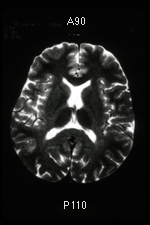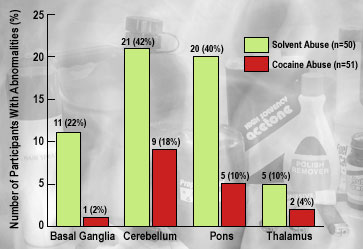Chronic inhalant abuse has long been linked to widespread brain damage and cognitive abnormalities that can range from mild impairment to severe dementia. Now a NIDA-funded study that compared brain damage and intellectual functioning among long-term inhalers of volatile solvents and cocaine abusers has found substantial brain abnormalities and cognitive impairment among both groups. However, considerably more inhalant abusers than cocaine abusers had brain abnormalities, their brain damage was more extensive, and they did significantly worse than cocaine abusers on tests of working memory and the ability to focus attention, plan, and solve problems.
 MRI Scan of 25-Year-Old Chronic Solvent Abuser. The scan shows diffuse, severe changes in cerebral white matter (center), which normally appears black on MRI. The fuzzy outline of the white matter suggests abnormal water retention.
MRI Scan of 25-Year-Old Chronic Solvent Abuser. The scan shows diffuse, severe changes in cerebral white matter (center), which normally appears black on MRI. The fuzzy outline of the white matter suggests abnormal water retention. MRI Scan of 28-Year-Old Chronic Solvent Abuser. The scan shows bilateral changes in the thalamus (two dark black ovals), normally gray and white, and suggests iron deposition.
MRI Scan of 28-Year-Old Chronic Solvent Abuser. The scan shows bilateral changes in the thalamus (two dark black ovals), normally gray and white, and suggests iron deposition."The extensive neurological damage and cognitive impairments we found among chronic solvent abusers in our study could limit their ability to control their behavior and perceive problems associated with their substance abuse," says Dr. Neil Rosenberg of the University of Colorado Health Sciences Center in Denver, who led the study. "As a result, a comprehensive approach that integrates neurological rehabilitation with drug abuse treatment may be needed to treat them successfully."
The study sought to clarify the type and extent of brain damage and neuropsychiatric impairment induced by chronic abuse of inhalants and cocaine. Researchers compared brain images and results of cognitive tests obtained from a large group of chronic, long-term solvent abusers with those of a comparable group of chronic cocaine abusers. Such information can be useful in developing appropriate treatment responses for both populations.
Fifty-five inhalant abusers completed a battery of cognitive tests, and 50 of them also underwent brain magnetic resonance imaging (MRI). In the comparison group, 61 cocaine abusers participated in cognitive testing, and 51 of them underwent brain MRIs.
Inhalant abusers inhaled primarily vapors from spray paint containing toluene, a commonly abused solvent found in many inexpensive household and industrial products, including correction fluids, paint thinners, and paint removers. Individuals in this group averaged more than 10 years of regular abuse of inhalants. Their patterns of abuse ranged from "sporadic and intense" through "continuously," with more than half of the group indicating they stayed high on solvents for most of every day. Participants in the comparison group had a similar history and pattern of chronically abusing other drugs, mainly cocaine and alcohol.
Both groups of drug abusers performed below general population averages on a series of tests that measured such cognitive functions as short-term memory, delayed recall, the ability to learn and make associations, and executive cognitive abilities. The low level of general intellectual functioning on most tests was similar for both groups, but inhalant abusers did significantly worse than cocaine abusers on tests involving working memory and executive cognitive functions, which include the ability to focus attention, plan, solve problems, and control one's behavior appropriately.
 Inhalant and Cocaine Abusers With Subcortical Abnormalities, by Brain Region Affected. Magnetic resonance imaging scans of chronic inhalant abusers and chronic cocaine abusers showed more frequent occurrence of abnormalities in the basal ganglia, cerebellum, pons, and thalamus for those who abused solvents.
Inhalant and Cocaine Abusers With Subcortical Abnormalities, by Brain Region Affected. Magnetic resonance imaging scans of chronic inhalant abusers and chronic cocaine abusers showed more frequent occurrence of abnormalities in the basal ganglia, cerebellum, pons, and thalamus for those who abused solvents.Both groups also had a high proportion of abnormal MRI scans, which reveal major changes in the structure of the brain. However, inhalant abusers were significantly more likely to have brain abnormalities than the comparison group. Almost half (44 percent) of the solvent abusers had abnormal MRIs compared to just over one-quarter (25.5 percent) of the comparison group. The relatively large numbers of inhalant abusers in the study enabled the researchers to show that the amount of past use of inhalants was related to the extent of brain abnormalities.
More solvent abusers than cocaine abusers had abnormalities in each of four brain structures the researchers examined -- the thalamus, basal ganglia, pons, and cerebellum. These structures play a critical role in receiving sensory information from the peripheral nervous system and the spinal cord and relaying messages throughout the brain that coordinate and control a variety of functions, including voluntary and involuntary movements. Common clinical consequences of pathological changes in these areas that have been reported in chronic inhalant abusers include difficulty coordinating movement, gait disorders, and spasticity, particularly in the legs. (See graph for comparison of abnormalities found in both groups in the four brain regions.)
Solvent abusers also had more extensive and more severe abnormalities in brain white matter (WM), a type of nerve tissue made up largely of specialized support cells and myelinated nerve fibers. Myelin is a white, fatty, insulating sheath that speeds up the transmission of nerve signals to different parts of the brain, including those involved in cognitive functions, such as language comprehension. The diffuse WM abnormalities found among solvent abusers in the study were associated with greater cognitive impairment. For example, the 12 percent of inhalant abusers who had diffuse moderate to severe WM abnormalities had a mean verbal IQ score that was nearly 20 percent lower than the already low average score registered by the rest of the group.
"Some of the brain damage and cognitive deficits seen in both primary inhalant and cocaine abusers in the study could stem from the heavy use of alcohol that was common among both groups," Dr. Rosenberg notes. "However, the diffuse white matter changes and abnormalities found in the thalamus have not been seen in alcohol abusers and are clearly from solvent abuse."
In spite of the extent of the neurologic damage and cognitive impairment the study found in chronic inhalant abusers, there is reason to be aggressive in treating them, Dr. Rosenberg says. "Every day we learn more about the ability of the central nervous system to regenerate. Our laboratory work suggests that the solvent-induced pathology that produces the primary MRI signal abnormality in the white matter results from alterations in the cellular membrane of nerve tissue. The pathology doesn't really look like it's destroying neurons or damaging their axons, the fiber-like extensions that send information to other cells. The picture suggests that if you can stop the inhalant abuse, there's a good chance you can get significant recovery of function in chronic abusers."
Source
- Rosenberg, N.L., et al. Neuropsychologic impairment and MRI abnormalities associated with chronic solvent abuse. Journal of Toxicology -- Clinical Toxicology 40(1):21-34, 2002. [Abstract]
